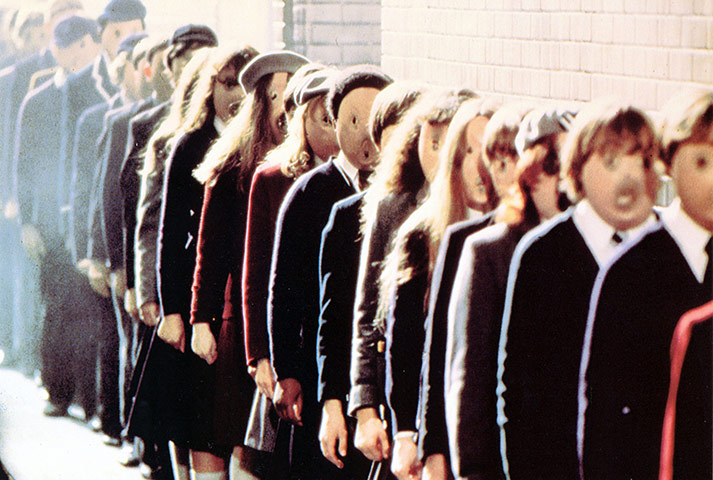Rhetorical Reading Response: Wendy Kaminer “The War on High Schools”
In Wendy Kaminer’s essay “The War on High Schools” (2001), she informs that instead of the school system allowing students to be expressive, they’re suppressing the individuality of the students. Kaminer develops the idea that students aren’t given the opportunity to be liberated by indicating different cases in which students were placed under disciplinary action for the words they uttered and the clothes they wore. Kaminer wrote this work in order to show that although the school system has its perks, there are certain actions that censor the students’ free speech and expressive dressings. The intended audience is the American school system.
 The reading was extremely interesting to me because it’s something I can relate to. I have a very bubbly and outgoing personality, but even starting in elementary school it began to be taken away. At my old high school, we wore uniform, and I hated it because it was as if my last bit of individually had been stripped away. I enjoyed reading this essay because it’s an issue that is constantly overshadowed but was brought to light. It’s something that I believe everyone needs to read. Kaminer stated, “How will most students learn about freedom when schools treat censorship, surveillance, and conformity as social goods?”, and it is a question that needs deep thought and reflection because there’s no way for us to learn to be independent individuals when we're treated as if we're in prison. Administrators in the school system may believe that they’re doing what is best for us, but instead, they’re diminishing our character and conforming us into who they (the system) wants us to be. This essay was very impactfully and every word of it is true.
The reading was extremely interesting to me because it’s something I can relate to. I have a very bubbly and outgoing personality, but even starting in elementary school it began to be taken away. At my old high school, we wore uniform, and I hated it because it was as if my last bit of individually had been stripped away. I enjoyed reading this essay because it’s an issue that is constantly overshadowed but was brought to light. It’s something that I believe everyone needs to read. Kaminer stated, “How will most students learn about freedom when schools treat censorship, surveillance, and conformity as social goods?”, and it is a question that needs deep thought and reflection because there’s no way for us to learn to be independent individuals when we're treated as if we're in prison. Administrators in the school system may believe that they’re doing what is best for us, but instead, they’re diminishing our character and conforming us into who they (the system) wants us to be. This essay was very impactfully and every word of it is true. Kaminer effectively used ethos throughout her essay to back up her argument. She gave plenty of examples to ensure that we understood the various ways school can restrict students. “Unhampered by logic, judges have ruled that clothing choices are not expressive” (Kaminer). In this quote, Kaminer tells us that clothing is not expressive, so it’s not being protected by the first amendment. She further elaborates on how certain t-shirts, like vegan shirts, could be considered as a gang symbol. Kaminer then states how education is becoming militarized. “Under law, they are now required to address all school employees as “sir’’ or “ma’am,” as in “yes, sir” or “yes, ma’am” (Kaminer). The quote tells us that elementary students can now break the law by not saying “yes, ma’am” or “yes, sir” to their elders. Kaminer describes the kids as little army recruits to show how harsh the law appears. “Police officers armed with real guns are being deployed in some schools in order to provide security” (Kaminer). This quote further shows the extremes some schools take to provide their own definition of security. Kaminer also says that random drug searches happen bimonthly because of the tighter security. To sum up, Kaminer provided many examples of how schools are making children act more like machines rather than allowing them to have their own freedom and act like human beings.
Kaminer effectively used ethos throughout her essay to back up her argument. She gave plenty of examples to ensure that we understood the various ways school can restrict students. “Unhampered by logic, judges have ruled that clothing choices are not expressive” (Kaminer). In this quote, Kaminer tells us that clothing is not expressive, so it’s not being protected by the first amendment. She further elaborates on how certain t-shirts, like vegan shirts, could be considered as a gang symbol. Kaminer then states how education is becoming militarized. “Under law, they are now required to address all school employees as “sir’’ or “ma’am,” as in “yes, sir” or “yes, ma’am” (Kaminer). The quote tells us that elementary students can now break the law by not saying “yes, ma’am” or “yes, sir” to their elders. Kaminer describes the kids as little army recruits to show how harsh the law appears. “Police officers armed with real guns are being deployed in some schools in order to provide security” (Kaminer). This quote further shows the extremes some schools take to provide their own definition of security. Kaminer also says that random drug searches happen bimonthly because of the tighter security. To sum up, Kaminer provided many examples of how schools are making children act more like machines rather than allowing them to have their own freedom and act like human beings.
Works Cited
Kaminer, Wendy. “The War on High School” LaunchPadSolo. Originally published in The American Prospect, November 2001 http://www.macmillanhighered.com/launchpadsolo/readwrite/7385790/Home#/launchpad/item/MODULE_bsi__2B8776E4__C845__493C__8BFF__4BCA15B8E06E/bsi__2DEA38E2__048E__4C77__9959__92ED7F70E8D8?mode=Preview&getChildrenGrades=True&includeDiscussion=False&readOnly=False&toc=syllabusfilter&renderIn=fne


